No apologies for the Casablanca reference!
Members of Gulf of Guinea X, our third marine expedition, have recently returned from scuba-sampling the inshore waters of Príncipe. The expedition was led by Dr. Luiz Rocha, chair of our Ichthyology Department and his colleague, Dr. Sergio Floeter, of the University of Santa Catarina, Brazil. The group consisted of seven divers including a São Tomean graduate student, Hugulay Maia; the team operated out of Roça Belo Monte, courtesy of Africa’s Eden, and used the dive boat of Makaira Lodge with our old friend Bobby Bronkhorst as skipper.
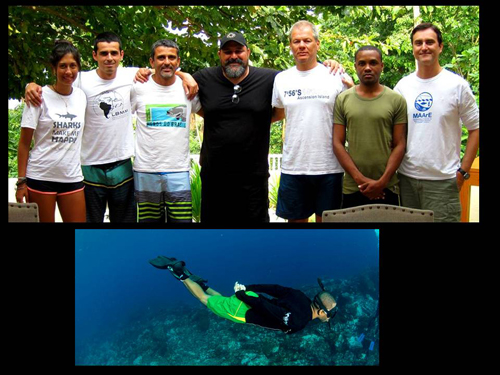
GG X team: (above, l to r) L. Fontoura,, R. Morais, Dr. Luz Rocha (leader), J. Gasparini, Dr. Cadu, H. Maia, Dr. S. Floeter. (below) Hugulay Maia earned SCUBA certification on this research trip.
The marine component is particularly important to our understanding of the scope of the biodiversity of the Gulf of Guinea Islands. Readers will recall that Príncipe is geologically the oldest island of the archipelago, originally rising from the ocean floor in the Oligocene, some 31 million years ago.
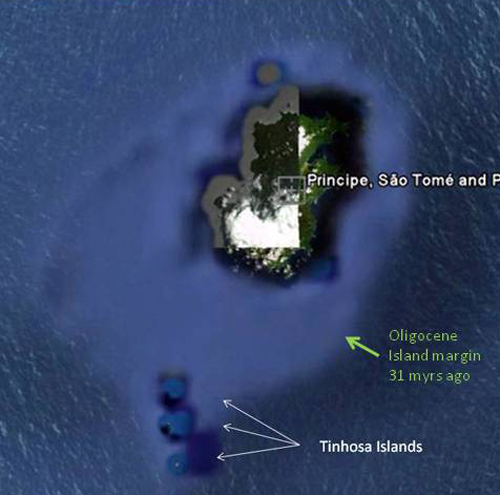
The early margins of the island (above), now weathered to 100m below sea level, are very old habitats. We can expect this region to have unique (endemic) species because as we know that species in isolation change over time; evolution occurs in marine habitats just as it does in terrestrial environments. Most of the specimens and tissues are yet to be analyzed but there are some early exciting discoveries:

Clepticus africanus, an endemic damselfish known only from the Gulf of Guinea Islands, from Sao Tome to Annobon.
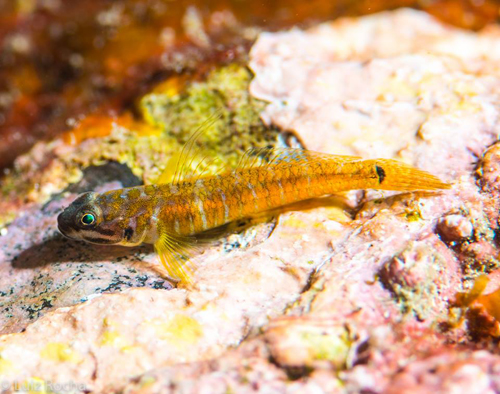
Lubbock’s goby, Corcyrogobius lubbocki: These are the second living specimens encountered in Principe since the species was orginally described in 1988. Previously, the species was known only from Ghana, and Annobon, the southernmost island in the archipelago.
 Sparisoma choati, Tomio’s parrotfish.
Sparisoma choati, Tomio’s parrotfish.
In the October 2011 blog I reported that a new species of parrotfish (above) was being described from a specimen caught on rod and reel by Dr. Tomio Iwamoto (CAS) from the pier of our friend Ned Seligman, in São Tomé during GG II (below). It is not everyday that a new species is caught from an old friend’s dock!! The GG X team just collected the first Príncipe specimens since then (above) and as you can see, they are quite different in coloration from the original specimen from the big island.
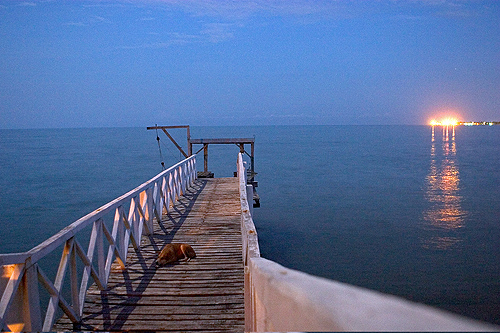
Type locality of Tomio’s parrotfish, Ned Seligman’s dock, Praia Francesa, Sao Tome.
While in the field, Dr. Rocha wrote:
“We are surprised to see such clear signs of overfishing in an island with only ~7,000 inhabitants. We saw no sharks, and the few large fish were very scared, a tell tale of spearfishing.
Part of Hugulay and Renato’s work is to interview local fishermen and try to get more clues of how bad overfishing is here. And their interviews reveal a problem that was even bigger than we thought: there are reports of dynamite fishing!”
https://www.calacademy.org/blogs/gulf-of-guinea-expeditions/where-are-the-fishes-0
In earlier blogs, I have included quite a few images of large fish caught just offshore on Príncipe over the years (below), so Dr. Rocha’s observations are disturbing.
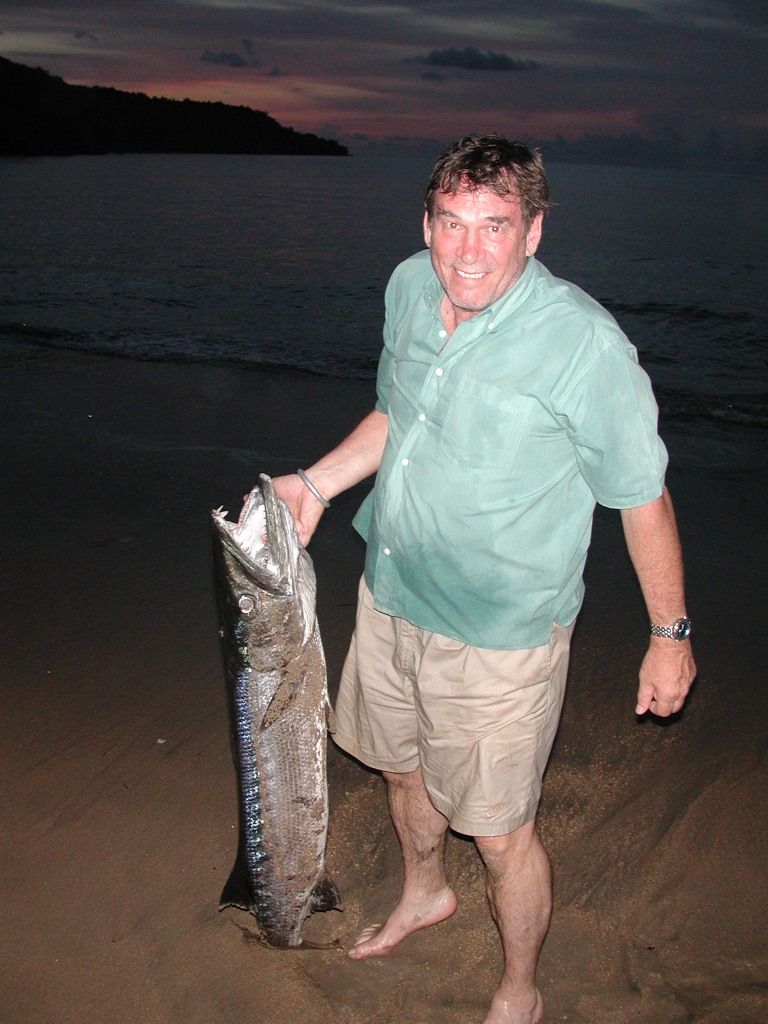
Twenty kg+ barracuda, caught off Praia Lemba-Lemba, Principe in 2001.
The dynamite or blast fishing issue is an especially critical one, as underwater habitat can be permanently destroyed as a result. The activity was originally brought to the attention of local authorities some years ago; nevertheless, most of the local inhabitants in the fishing industry know about it according to the team, and indications are that it continues in spite of government efforts.
Príncipe was named a UNESCO World Biosphere Reserve in 2013, and I am proud to add that the scientific results of our multidisciplinary expeditions played a positive role in the island’s recognition as a unique place on the globe. Apart from the obvious long-term economic and environmental consequences of continued blast fishing, Príncipe’s World Biosphere status could make this activity extremely visible internationally and embarrassing. As of 2007, 403 inshore fish species have been listed for this tiny 10002 km island. Unchecked and unstudied over fishing in these idyllic tropical waters will disastrously degrade the incredible biodiversity levels of this ancient island.
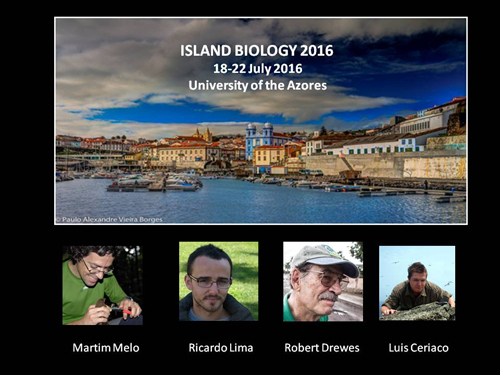
This summer my colleagues Martim Melo, Ricardo Lima, Luis Ceríaco and I are all attending the international conference on island biology which is being held the University of the Azores. We are organizing a special symposium on the Gulf of Guinea Islands, and Dr. Lima is leading an afternoon sub-session on conservation. He is the author of a recent article (below) on habitat loss in São Tomé and Príncipe and hopefully the session will lead to a discussion of major ecological issues such as this and blast fishing.
Our work has enjoyed the support of the government since Gulf of Guinea I in 2001; one of our good friends, Jose Cassandra, is Regional President of Príncipe.

Office of Hon. Jose Cassandra (left) with Dr. Maria Jeronimo and myself. A. Stanbridge phot. (GG IX)
Prior to a workshop on green economy by UNESCO, the people of Santo Antonio had a general clean-up of the town. Below are two photos of President “Toze,” helping clean up the Rio Papagaio (Parrot River) that runs through town. Suffice to say, he is a charismatic leader and a good friend.


Another blog will be forthcoming soon as we prepare for the conference and GG XI in the Fall. It is also time to formulate our primary school education efforts for the coming season.
The parting shot:

One of our third grade classes! We will visit them and nearly 2000 other primary schoolers during GG XI when they are in the fourth grade. A. Stanbridge phot. GG IX
PARTNERS:
The research expeditions and the primary school education program are supported by tax-deductable donations to the “California Academy of Sciences Gulf of Guinea Fund”* We are grateful for ongoing governmental support, especially to Arlindo de Ceita Carvalho, Director General, Victor Bomfim, and Salvador Sousa Pontes of the Ministry of Environment, Republic of São Tomé and Príncipe for their continuing authorization to collect and export specimens for study, and to Ned Seligman, Roberta dos Santos and Quintino Quade of STePUP of Sao Tome http://www.stepup.st/, our “home away from home”. GG VIII and upcoming GG XI have been funded by a generous grant from The William K. Bowes Jr. Foundation, and substantial donations from Mrs. W.H.V.“D.A.” Brooke, Thomas B. Livermore, Rod C. M. Hall, Timothy M. Muller, Prof. and Mrs. Evan C. Evans, Mr. and Mrs. John L. Sullivan Jr., Clarence G. Donahue, Mr. and Mrs. John Sears, and a heartening number of “Coolies”, and members of the Docent Council of the California Academy of Sciences. Once again we are deeply grateful for the support of the Omali Lodge (São Tomé) and Roça Belo Monte (Príncipe) for both logistics and lodging and for partially sponsoring our education efforts for GG VII and GG VIII.
*California Academy of Sciences
55 Music Concourse Dr.
San Francisco, CA 94118
USA
